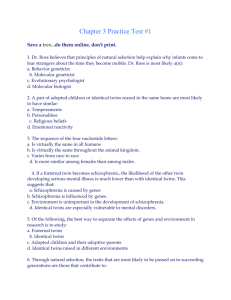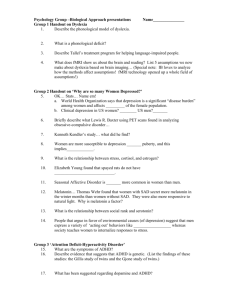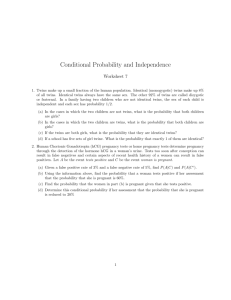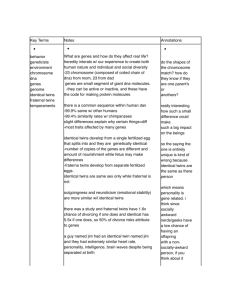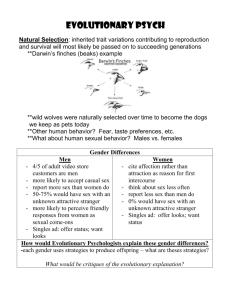study of personality difference among identical twins and fraternal
advertisement
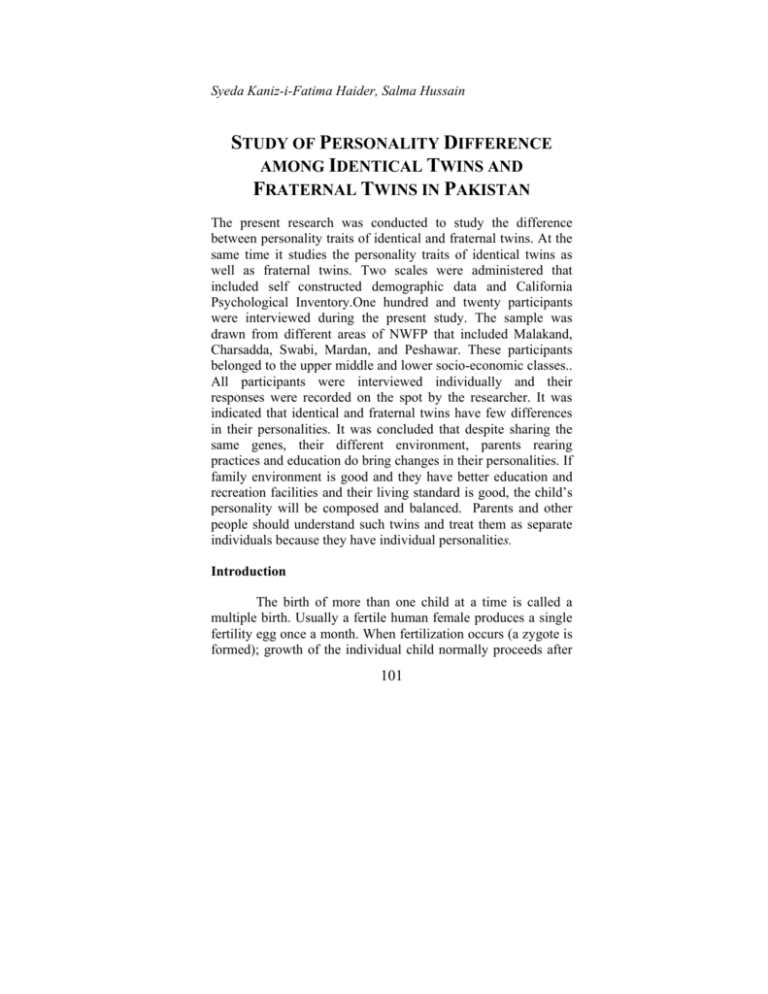
Syeda Kaniz-i-Fatima Haider, Salma Hussain STUDY OF PERSONALITY DIFFERENCE AMONG IDENTICAL TWINS AND FRATERNAL TWINS IN PAKISTAN The present research was conducted to study the difference between personality traits of identical and fraternal twins. At the same time it studies the personality traits of identical twins as well as fraternal twins. Two scales were administered that included self constructed demographic data and California Psychological Inventory.One hundred and twenty participants were interviewed during the present study. The sample was drawn from different areas of NWFP that included Malakand, Charsadda, Swabi, Mardan, and Peshawar. These participants belonged to the upper middle and lower socio-economic classes.. All participants were interviewed individually and their responses were recorded on the spot by the researcher. It was indicated that identical and fraternal twins have few differences in their personalities. It was concluded that despite sharing the same genes, their different environment, parents rearing practices and education do bring changes in their personalities. If family environment is good and they have better education and recreation facilities and their living standard is good, the child’s personality will be composed and balanced. Parents and other people should understand such twins and treat them as separate individuals because they have individual personalities. Introduction The birth of more than one child at a time is called a multiple birth. Usually a fertile human female produces a single fertility egg once a month. When fertilization occurs (a zygote is formed); growth of the individual child normally proceeds after 101 102 [J.R.S.P., Vol. 46, No. 2, 2009] the fertilized egg has become implanted within the wall of the uterus (womb). In rare circumstances two unfertilized eggs at one time are released in the ovaries; each egg may be a fertilized genetics of human. The exact reason for twin birth is not known. Most of the doctors and researchers have identified several reasons for such a probability. Sometimes twin births run in the family. It is more common for a woman to have a twin birth when one has already occurred in her family (Azalete Bolger Wells ,2006). People used to believe that the births of twins skip generations and according to research, women, who are taller and heavier are more likely to have twins. Similarly if a woman has already had fraternal twins, the chances of her having another set are more than a woman who has never had twins. However, the main reason for rise in twin births is the use of fertility medicines. According to Bergeman, Plomin, McClearn, Pederson, and Friberg, (1998), one-third of the increase in multiple conceptions is due to the fact that now conceiving women over the age of 30 (who are more likely to conceive multiples) are numbered more than younger women. Another reason is the use of fertility-stimulating drugs and Assisted Reproductive Techniques (ART) such as In Vitro Fertilization (IVF). In this technique eggs are removed from the mother, fertilized in a laboratory and then transferred to the uterus. According to the most recent survey of ART programs in the United States, 56 percent of births resulting from these procedures were multiples. Developmental Patterns of Twins It is important to recognize twin babies as two separate individuals right from their birth. Benirschike, (2004) explains that if they are identical, it is easy to treat them as a "package," providing them with the same clothing, toys and quality of attention. But, as similar as they may appear physically, emotionally they are different and in order to grow up happy and secure as individuals, their differences need to be supported. Both identical and fraternal twins may become either Study of Personality Difference … 103 competitive or interdependent as they grow up. Sometimes one twin acts as the leader and the other as the follower. Whatever the specific quality of their interaction, most twins develop very intense relationships early in life simply because they spend so much time together. Development of twins is never on the same pattern as like other children of their age. Ebelinh , Porkka , et, al (2003) elucidate that some twins seem to "split the work," with one concentrating on motor skills, while the other stresses on social or communication abilities. In fact they spend much of their time together and have good communication with each other rather than with other family members or friends. They learn how to read each other's gestures and facial expressions and occasionally they even have their own verbal language that no one else can understand. (This is particularly true of identical twins.) They can entertain each other and are not be very keen to learn about the world beyond theirs. This unique developmental pattern does not represent a problem, but it does make them stand out and exposes them individually to other playmates and learning situations. Similarly just like other brothers and sisters, twins and triplets do not always get along. When brothers and sisters fight, it is sometimes called sibling rivalry. This is common among twins and triplets too. In fact being the exact same age it might make competition between the two (or three or more!) even more intense. Similarly, Girela, Lorente, Alvarez , and Rodrigo (1999) enlighten that they might have the same friends, teachers, and coaches who do not think of them as individuals. It can be really frustrating when people constantly compare twins to or always associate them with their sibling. (Douglas, 2004). Twins are not always happy about being apart, especially if they have established strong play habits and preferences for each other's company. For this reason, it is important to begin separating them occasionally at an early stage. If they resist strongly, try a gradual approach with familiar children or adults to play with them individually in the same 104 [J.R.S.P., Vol. 46, No. 2, 2009] room or play area. According to Klump, Holly, and Lacono, (2000) a separate approach is necessary to develop at school age, because in nursery school, most twins can stay together in the same room, but many elementary schools prefer twins to be in separate classes. Personality Differences of Twins Personality is a frequently cited example of an inherited trait that has been studied in twins and adoptions. Identical twins reared apart are far more similar in personality than randomly selected pairs of people. Likewise, identical twins are more similar than fraternal twins. Also, biological siblings are more similar in personality than adoptive siblings. Each observation suggests that personality is inherited to a certain extent. However, these same study designs allow for the examination of environment as well as genes. Mari, (2001) Typically, two kinds of environmental effects are distinguished: shared family effects (those shared by siblings, making them more similar) and non-shared effects (which uniquely affect individuals, making siblings different). Segal, Hershberger, and Arad, (2003) stated in their research that although they are genetically identical and share the same family environment, identical twins reared together do not have identical personalities. These differences are caused entirely (by definition) by non-shared environmental effects. Adoption studies also directly measure the strength of shared family effects. Adopted siblings share only family environment. Unexpectedly, some adoption studies indicate that by adulthood the personalities of adopted siblings are no more similar than random pairs of strangers. Pamela, Prindle, and Fierro, (2007) strongly suggest that this would mean that shared family effects on personality are zero by adulthood. As is the case with personality, non-shared environmental effects are often found to out-weigh shared environmental effects. That is, environmental effects that are typically thought to be lifeshaping (such as family life) may have less of an impact than non-shared effects, which are harder to identify. In the same Study of Personality Difference … 105 way, Melissa Knopper, (2002) explains that one possible source of non-shared effects is the environment of pre-natal development. Random variations in the genetic program of development may be a substantial source of non-shared environment. These results suggest that "nurture" may not be the predominant factor in "environment". Heather (2005) stated that personality is a good example of a trait that has been studied in twins. Identical twins reared apart are far more similar in personality than fraternal twins. These observations suggest that personality is inherited. However, the environment must also be looked at. The studies of twins do give us some clues and shows that different aspects of personality are differentially subject to hereditary influences. Evidence from twins’ studies of personality suggests that traits referred to as active, vigorous, impulsive and sociable are inherited, where as dominant, stable, and reflective are not, or at least are much less (Vandenberg, 1967). Similarly, different types of personality disorders seem to be participants to different degrees of hereditary influence. A study conducted by Olson, Vernon, Harris, and Jang, (2001) indicates that neuroses characterized by anxiety, depression, obsession, and schizoid withdrawal have a substantial genetics basis, while those with features of hypochondrias and hysteria are mostly environmental in origin. Hughes, Happé, Taylor, Jaffee, Caspi, and Moffitt, (2005) stated in their study that was designed to measure personality traits of extraversion and neuroticism among the twin pairs, traits of impulsivity and monotony avoidance, and family environment and socio-economic status. Using this information, and taking into consideration that a study like this had never been done before, the researchers came to three different conclusions in regards to genotype-environment interaction. Similarly, Robert Krueger (2002) stated that genotypeenvironment interaction is a term used by many researchers in relation to twin studies, referring to the potential for people with different genetic makeup to respond differently toward the same 106 [J.R.S.P., Vol. 46, No. 2, 2009] external situation. This is an important concept in twin studies because genotype-environment interaction can also be applied to how people with the same genotypes might respond to the same environment. Surendra Khanal (2002) OBJECTIVES The purpose of the present research is to study: 1. The similarities and differences between personalities of identical twins and fraternal twins 2. The similarities and differences in personalities of identical twins. 3. The similarities and differences in personalities of fraternal twins. The present research was conducted in the following steps Selection of Sample The researcher published columns in different newspapers to collect information about twins from all areas of N.W.F.P. The participants were selected on the basis of their availability through convenient sampling technique .Sample of sixty identical twins and sixty fraternal twins, age ranging between 15 to 25 years were selected and interviewed from five major areas of N.W.F.P. Participants belonged to different age group, sex and socio-economic status, including upper, middle and lower class but most of them belonged to middle class families. The male ratio in the selected sample was comparatively greater than females. Administration of the Scales Two major scales were administered on identical twins and fraternal twins. First the demographic data was administered and then the CPI was administered on identical twins and fraternal twins for personality factors. Study of Personality Difference … 1. 107 Demographic Information Scale Demographic scale was developed and administered on participants in order to get general information about the age, gender, education, family status, and birth order of identical twins and fraternal twins. 2. California Psychological Inventory (CPI) Harrison Gough developed the California Psychological Inventory in 1957. The California Psychological Inventory (CPI) was a self-report inventory created by Harrison Gough and published by Consulting Psychologists Press. It was created in a similar manner as of Minnesota Multiphase Personality Inventory (MMPI), but unlike the MMPI, it is not concerned with maladjustment or clinical diagnosis, but concerns itself with more "normal" aspects of personality. Bano (1998) determined the validity and reliability of CPI in Pakistan. The coefficient of correlation range from 0.41 to 0.88 with a median 0.65.which revealed positively significant correlation (P<. 01 and .05) exists among CPI scales. Correlations between CPI scales and related external criteria tend to fall in the .2 to .5 ranges. This degree of correlation is typical for much of personality research. Extremely high correlations are not likely to be found for personality measures because the scales rather try to assess broad behavioral tendencies. Norms were available for males-only, females-only and male/female data combined. The CPI has been very popular in research and in individual assessments of adolescents and adults. This fact that was developed and the norm on non-psychiatric or non-clinical population were regarded almost universally as part of its positive reputation and usefulness among psychologists. Results 108 [J.R.S.P., Vol. 46, No. 2, 2009] Finding of the present study demonstrates significant similarities in personalities of twins. The results indicated that family environment played a very important role in the making of their personalities. Table-1 Correlation Matrix of Different Variables of California Psychological Inventory RES DOM IND SOC SELF -CON TOL INT.E FF RES - DOM .249 - IND .065 .702 ** - SOC .5701 ** .433 ** .320 * - SELFCON .521* * .416 ** .304 * .564 ** - TOL .465* * .477 ** .479 ** .594 ** .580 ** - INT.E FF .339* * .484 ** .441 ** .480 ** .400 ** .581 ** - FLEX .380* * .282 * .347 ** .328 * .263 * .230 .293* FLE X - Note: Read RES as Responsibility, DOM as Dominance, IND as Independence, SOC as Socialization, SELF-CON as SelfControl, TOL as Tolerance, and INT.EFF as Intellectual Efficiency and FLEX as Flexibility. 109 Study of Personality Difference … Table- shows highly significant correlation between the selected variables from the CPI (California Psychological Inventory). Every variable showing high significant with other variables such as some of highly significant correlation variables are responsibility with socialization, self-control, tolerance, similarly dominance with independence, socialization, intellectual efficiency, flexibility. Table-2 Mean difference, Standard deviation and t-value of Identical and Fraternal Twins on CPI (n=120) Group Fraternal Identical (n=60) (n=60) CPI Mean SD Mean SD t-value Responsibility 84.90 3.632 95.23 3.191 .378 Dominance 21.50 3.287 21.16 3.591 .375 Independence 18.93 3.768 18.46 3.191 .518 Socialization 36.46 4.811 56.63 4.649 .136 Self Control 19.46 4.703 19.80 5.202 .260 Tolerance 17.86 4.023 18.56 4.500 .635 Intellectual Efficiency 22.90 4.551 24.06 3.268 1.140 Flexibility 56.46 3.329 21.23 2.284 .317 In Table-2 scores on CPI shows that both type of twins have same characteristics and less differences in their personality traits. Both types are equally dominant, independent, tolerant, and intellectually efficient and have self-control, but the difference between the two was not found significant, the only 110 [J.R.S.P., Vol. 46, No. 2, 2009] significant difference was found in responsibility, socialization and flexibility Table-3 Mean difference, Standard deviation and t-value of Fraternal Twins on CPI (n=60) Group Group-1 Group-11 (n=30)girls (n=30)boys CPI Mean SD Mean SD t-value Responsibility 94.93 3.195 94.86 4.138 .049 Dominance 11.26 3.195 21.73 3.473 .383 Independence 12.33 3.658 19.53 3.907 .868 Socialization 36.06 3.990 56.86 5.629 .110 Self Control 18.53 3.925 20.40 5.342 1.090 Tolerance 17.13 3.777 18.60 4.256 .998 Intellectual Efficiency 21.93 4.847 21.86 4.172 1.171 Flexibility 21.60 2.957 21.33 3.773 .216 Table-3 shows that within fraternal group-2 twins have greater sense of dominance, independence and are socialized. The difference between the scores on sub-scale of responsibility, self-control, tolerance, intellectual efficiency and flexibility within group was not found significant. Majority of the fraternal twins from group-2 were found to be participating in social activities in their educational as well as in other institutions. 111 Study of Personality Difference … Table-4 Mean difference, Standard deviation and t-value of identical Twins on CPI (n=60) Group Group-1 Group-11 (n=30) (n=30) CPI Mean SD Mean SD tvalue Responsibility 96.06 3.972 94.40 1.956 1.458 Dominance 21.00 3.207 21.33 4.047 .250 Independence 81.33 3.109 81.60 .225 3.376 Socialization 56.33 5.639 56.93 3.575 .348 Self Control 20.06 6.052 19.53 4.389 .276 Tolerance 18.66 5.009 18.46 4.103 .120 Intellectual Efficiency 24.93 3.058 23.20 3.342 1.482 Flexibility 21.06 2.548 21.40 2.063 .394 Table-4 shows that scores of identical twins were almost same on sub-scales of CPI except self-control and intellectual efficiency. Discussion Findings of the study demonstrate significant similarities among personalities of identical and fraternal twins. Identical twins have less difference in their personality traits as compared to fraternal twins; it was found that bringing up in the same family environment also brings the similarities in personalities of identical twins. Identical twins share all of their genes. Fraternal twins share one-half of their genes. According to Herin (2006) if 112 [J.R.S.P., Vol. 46, No. 2, 2009] phenotypic variation is caused largely by genetic variation, the identical twins will be more similar to each other than fraternal twins. If phenotypic variation is caused largely by environmental variation, then identical and fraternal twins will be equally similar. The difference between personality traits within identical and fraternal twins was lesser because same family environment plays an important role in the bringing up of the twins. Manfred David Mann (1998) study showed that when identical same-sex twins are brought up in the same environment and their treatment is also the same (clothing included) they usually behave and feel much the same. If they are brought up as individuals they also have the same personalities; if one is dominant, the other is also dominant. But when fraternal twins are brought up in the same environment then usually one is more dominant.The results show that identical twins are more similar to each other in their personality traits. Study of Personality Difference … 113 Notes and References Azalete Bolger Wells (2006) Santa Clara County Mothers Of Twins Club National Organization of Mother of Twins Club Bergeman, C. S., Plomin, R., McClearn, G. E., Pederson, N. L., & Friberg, L. T. (1998). Genotype-environment interaction in personality development: Identical twins reared apart. Psychology and Aging, 3, pp. 399-406. Benirschike K, (2004), "Multiple Gestations" in Creasy RK, Resnik R, Maternal-Fetal Medicine: Principles and Practice, (5th ed), pp 55-62. Philedelphia: Saunders. Douglas A. Berstein, Edward J. Roy, Thomas K. Srull, & Christopher D. Wickens Ebelinh H., Porkka T, et, al (2003). Inter-twin relationships and mental health, Clinic of Child Psychiatry, Department of Paediatrics, University and University Hospital of Oulu, Oulu, Finland Girela E, Lorente JA, Alvarez JC, & Rodrigo MD (1999). Indisputable double paternity in dizygous twins, Fertility and Sterility, 67(6): pp. 1159-61 From http://en.wikipedia.org/wiki/Twin Hughes, C., Happé, F., Taylor, A., Jaffee, S. R., Caspi, A., & Moffitt, T. E. (2005). Origins of individual differences in theory of mind: From nature to nurture? Child Development, 76, pp. 356-370. Heather A.Blout (2005). Nature Versus Nurture: Are We Really Born That Way? Klump, K. L., Holly, A., & Lacono, (2000). Physical similarity and twin resemblance for eating attitudes and behaviors: A test of the equal environments assumption. Behavior Genetics, Vol 30, pp. 51-58 114 [J.R.S.P., Vol. 46, No. 2, 2009] Mari, G., (2001) Prenatal Morbidity And Mortality Rates In Severe Twin-Twin Transfusion Syndrome. American Journal of Obstetrics and Gynecology, Vol 185, pp. 708–715 Melissa Knopper, (2002). The Gale Group Inc., Gale, Detroit, Gale Encyclopedia of Genetic Disorders Part I, Manfred David Mann (1998). Similarities and Differences of Twins, www.healthline.com Olson, J. M., Vernon, P. A., Harris, J. A., & Jang, K. L. (2001). The heritability of Attitudes: A study of twins. Journal of Personality and Social Psychology, 80, 845-860. Pamela, Prindle, & Fierro, (2007). Identical or Fraternal? Determining Zygosity in Multiple Parenting of Multiples Robert Krueger (2002). Where personality goes awry, the Journal of Personality, Vol. 70, No. 5 Segal, N. L., Hershberger, S. L., & Arad, S. (2003). Meeting one’s twin: Perceived social closeness and familiarity. Evolutionary Psychology, vol 1, pp. 70-95 Surendra Khanal (May 2002). post Newspaper in Katmandu Multiple Conceptions, Sunday Vandenberg, James L. McGaugh, Richard F. Thompson, Thomas O. Nelson (1967). Psychology1, p. 33



